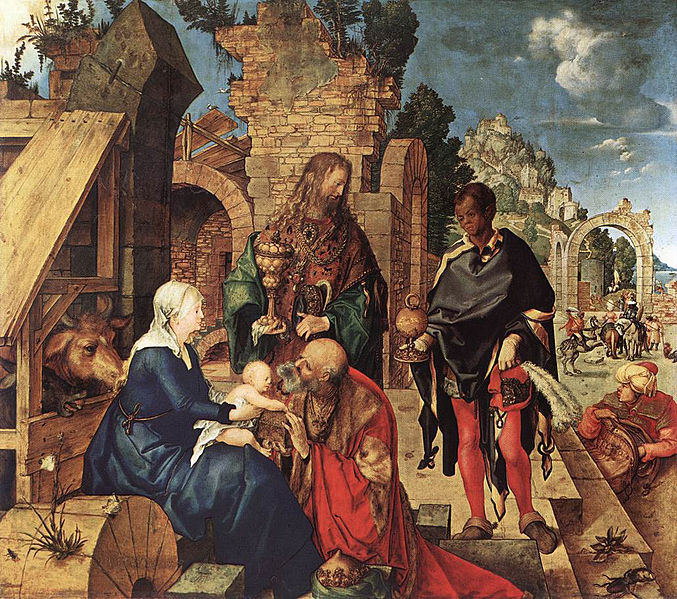by Deaconess Carolyn Brinkley
In 1517 when Luther nailed his 95 Theses to the door of the Castle Church in Wittenberg, Albrecht Dürer’s magnificent painting, Adoration of the Magi, hung just inside the church mere feet away. Thirteen years earlier Frederick the Wise had commissioned Dürer to paint the masterpiece for the Schlosskirche altar. The painting remained in Wittenberg until 1604 when it was taken to Vienna and gifted to Rudolf II, the Holy Roman Emperor. Today it resides at the Uffizi in Florence, Italy. The painting is oil on wood and measures 100 cm by 114 cm.
Art critics talk of perspective and proportions, but we will view the Epiphany scene through the lens of Holy Scripture with the eyes of faith. In Albrecht Dürer’s exquisite Adoration of the Magi we become participants in the Matt. 2 account giving opportunity to worship the Christ Child alongside Wise Men from the East. Dürer’s style is inviting. He deliberately draws you in and gives you a place so that you are an eye witness to this holy event. Do you see the flat moss covered stone next to Mary? On it Dürer’s distinctive “AD” monogram can faintly be seen. This is your place to sit and adore the Incarnate God. Dürer stations you so close that you can almost touch “The Word Made Flesh” and caress His chubby arms. Here you see the embodiment of the Nicene Creed, “who for us men and for our salvation came down from heaven.”
In the foreground corners we see ancient icons that give a concise synopsis of Christ’s redemptive work. At the right, picturing the first promise of a Savior in Genesis 3:15, the crab symbolizes being bitten in the heel and the green plantain, known for its healing powers, portrays the shed blood of the Savior, who “was crucified for us under Pontius Pilate. He suffered and was buried.” On the left, butterflies, icon of the resurrection, flit above the millstone suggestive of the stone at the empty tomb. “And the third day He rose again according to the Scriptures.”

At the center of the painting, a crumbling architectural ruin reaches to the sky. This symbolizes not only the decay of our world, but also the brokenness of our very own bodies and souls brought about by man’s deliberate choice to obey Satan and not God. It is to this sin sick world that the Creator humbled Himself to be born a creature, “and was incarnate by the Holy Spirit of the virgin Mary and was made man.”
Do you see the billowing cloud in the upper right? It is a Renaissance icon for the presence of “God the Father Almighty, maker of heaven and earth.” The turquoise sky sets off the richness of the golds, greens, and reds creating a luxurious glow of soft mellow light in the center of the painting. But where is the star? Do you see it? The Morning Star is in the virgin’s arms! “God of God, Light of Light, very God of very God!” Baby Jesus is not passively nestling in the safety of His mother, but is deliberately embracing the earthly gift offered by the kneeling Magi, as if to say, “I Am The Gift who will freely give you eternal treasures of forgiveness, life and salvation through My holy body and blood.” In the background Dürer paints a visual prophecy of the death of Christ as Herod’s horsemen rally in their quest to kill the Infant King. But surrounding God the Child there is only sublime peace and joy of the Gentile Christmas. Even the animals are rejoicing. The ox nuzzles Mary’s back attempting to touch the One who will free all creation from bondage. The ass brays his song of jubilation! In the gathering of the Magi we see “one holy Christian and apostolic Church.” All peoples and all nations are represented by the old man on bended knee, Albrecht Dürer standing behind him, the African in dark green, and the turbaned Oriental still unpacking his gift. And you! And me!
Deaconess Carolyn S. Brinkley is the Military Project Coordinator at Concordia Theological Seminary in Ft. Wayne, IN.